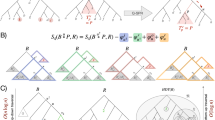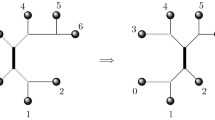Abstract
The method of nearest-neighbor interchange effects local improvements in a binary tree by replacing a 4-subtree by one of its two alternatives if this improves the objective function. We extend this to k-subtrees to reduce the number of local optima. Possible sequences of k-subtrees to be examined are produced by moving a window over the tree, incorporating one edge at a time while deactivating another. The direction of this movement is chosen according to a hill-climbing strategy. The algorithm includes a backtracking component. Series of simulations of molecular evolution data/parsimony analysis are carried out, fork=4, ..., 8, contrasting the hill-climbing strategy to one based on a random choice of next window, and comparing two stopping rules. Increasing window sizek is found to be the most effective way of improving the local optimum, followed by the choice of hill-climbing over the random strategy. A suggestion for achieving higher values ofk is based on a recursive use of the hill-climbing strategy.
Similar content being viewed by others
References
CAMIN, J. H., and SOKAL, R. R. (1965), “A Method for Deducing Branching Sequences in Phylogeny,”Evolution, 19, 311–326.
DAYHOFF, M. O. (1969), “Computer Analysis of Protein Evolution,”Scientific American, 221, 57–95.
ECK, R. V., and DAYHOFF, M. O. (1966),Atlas of Protein Sequence and Structure, Washington: National Biomedical Research Foundation.
FITCH, W. M. (1971), “Towards Defining the Course of Evolution: Minimum Change for a Specific Tree Topology,”Systematic Zoology, 20, 406–416.
HARTIGAN, J. A. (1973), “Minimum Mutation Fits to a Given Tree,”Biometrics, 29, 53–65.
MADDISON, D. R. (1991), “The Discovery and Importance of Multiple Islands of Most Parsimonious Trees,”Systematic Zoology, 40, 315–328.
SANKOFF, D., ABEL, Y., CEDERGREN, R. J., and GRAY, M. W. (1988), “Supercomputing for Molecular Cladistics,” inClassification and Related Methods of Data Analysis, Ed., H.H. Bock, Amsterdam: North-Holland, 385–394.
SANKOFF, D., and ROUSSEAU, P. (1975), “Locating the Vertices of a Steiner Tree in an Arbitrary Metric Space,”Mathematical Programming, 9, 240–246.
SWOFFORD, D. L. (1990), “PAUP: Phylogenetic Analysis Using Parsimony. Version 3.0, Champaign: Illinois Natural History Survey.
SWOFFORD, D. L., and OLSEN, G.,J. (1990), “Phylogeny Reconstruction,” inMolecular Systematics, Eds., D. M. Hillis and C. Moritz, Sunderland, MA: Sinauer, 411–501.
Author information
Authors and Affiliations
Additional information
Acknowledgments: This work was supported in part by grants to the first author from the Natural Sciences and Engineering Research Council (Canada) and theFonds pour la formation de chercheurs et l'aide à la recherche (Québec), and to the third author from the Danish Research Council. The first author is a fellow of the Canadian Institute for Advanced Research. Much of the research was carried out in the spring of 1991 while the first author was visiting the University of Geneva; warmest thanks are due Professor Claude Weber for this opportunity.
Rights and permissions
About this article
Cite this article
Sankoff, D., Abel, Y. & Hein, J. A tree · a window · a hill; generalization of nearest-neighbor interchange in phylogenetic optimization. Journal of Classification 11, 209–232 (1994). https://doi.org/10.1007/BF01195680
Issue Date:
DOI: https://doi.org/10.1007/BF01195680




